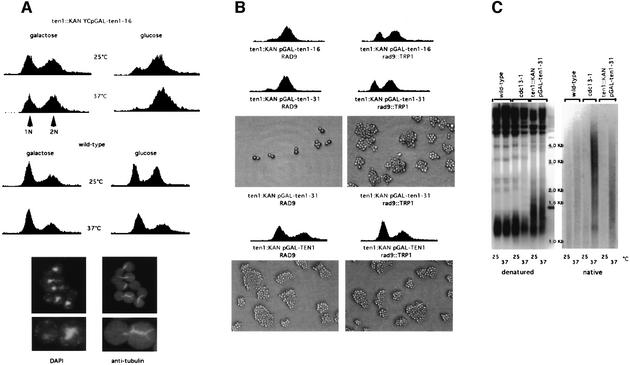Fig. 2. The arrest conferred by the temperature-sensitive ten1-16 and ten1-31 mutant alleles occurs at G2/M and depends on the Rad9-mediated DNA damage checkpoint. (A) Top: FACS analysis of ten1 arrested cells. Cells disrupted for TEN1 (ten1::kanMX4) and surviving owing to the presence of the temperature-sensitive ten1-16 allele on a single-copy plasmid, under the control of the GAL1 promoter (ten1::KAN YCpGAL-ten1-16), were grown to mid-log phase at 25°C and shifted up to 37°C for 4 h or left at 25°C, either on galactose-based medium, a condition that induced expression of the ten1 allele, or on glucose-based medium, and prepared for FACS analysis, together with wild-type control cells. The ten1 mutant cells arrested in G2/M on glucose medium at 37°C. When grown on glucose medium at 25°C or on galactose medium at 37°C, these mutant strains became enriched in dumb-bell-shaped cells but still continued to grow. ten1-31 cells behaved similarly (not shown). Bottom: cells from the ten1::kanMX4 YCp111-GAL1-ten1-31 strain were grown on galactose-based medium at 25°C, then on glucose-based medium at 37°C (repressive conditions), fixed 4 h later and processed for tubulin immunofluorescence and staining of the DNA with DAPI. Arrested ten1 mutant cells contained a single nucleus located close to the neck joining the mother and daughter. They also exhibited a short tubulin spindle, typical of a G2/M arrest, extending through the nucleus between the two duplicated spindle bodies. (B) Cell cycle profiles of ten1 mutant cells bearing (rad9::TRP1, right) or not (RAD9, left) a disruption of RAD9, a DNA damage checkpoint gene, were fixed for FACS analysis 4 h after transfer to glucose medium at 37°C, a condition that inactivated these temperature-sensitive ten1 alleles. In the presence of the rad9 mutation, both the ten1-16 and ten1-31 mutant cells failed to mark the G2/M arrest exhibited by the RAD9+ ten1 cells. As a consequence, rad9 ten1 double mutants continued to proliferate for a few cell divisions, as attested by their ability to form numerous microcolonies (shown only for ten1-31), a phenotype indicative of a checkpoint defect. In contrast, RAD9+ ten1-31 cells, which are checkpoint proficient, stopped progression through the cell cycle. Meanwhile, ten1 disruptants bearing wild-type TEN1 (ten1::KAN pGAL-TEN1) bearing (rad9::TRP1) or not (RAD9) a disruption of RAD9, and growing on galactose medium, continued to proliferate indefinitely. (C) Non-denaturing Southern hybridization to a Y′ 32P-labelled probe (native, right) revealed the presence of abnormally high levels of single-stranded DNA in the telomeric regions of ten1-31 mutant cells (ten1::TRP1 pGAL-ten1-31) at 37°C. Cells were grown on galactose-based medium at 25°C, then for 4 h on glucose-based medium at 37°C (repressive conditions) or 25°C (permissive conditions) and harvested for preparation of genomic DNA. cdc13-1 mutant cells grown at 37°C were used as a positive control, while cdc13-1 cells grown at the permissive temperature of 25°C and wild-type cells grown at 25 or 37°C served as negative controls. Genomic DNAs from these same strains were run in parallel and processed for hybridization with the same probe under denaturing conditions (denatured, left) to serve as additional controls.

An official website of the United States government
Here's how you know
Official websites use .gov
A
.gov website belongs to an official
government organization in the United States.
Secure .gov websites use HTTPS
A lock (
) or https:// means you've safely
connected to the .gov website. Share sensitive
information only on official, secure websites.
